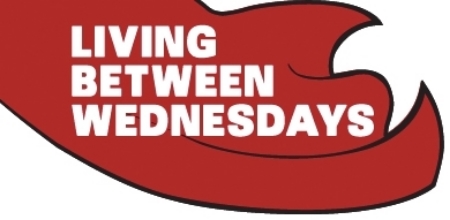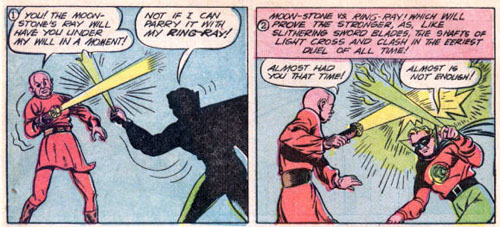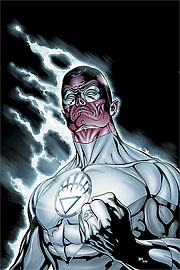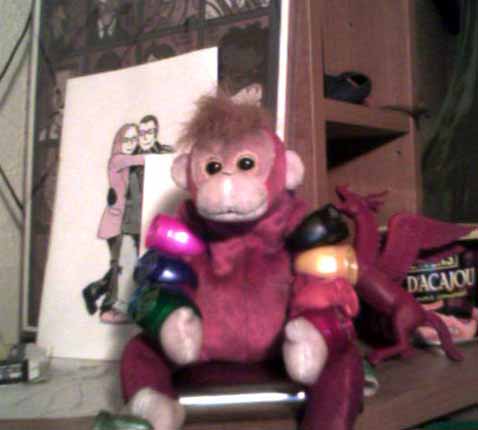
So, I think it’s fair to say that I liked Blackest Night #1 a lot better than my blogmates here at LBW (with the exception of Tiina who, to my knowledge, hasn’t read it yet). However, I should qualify this by saying that I am also a huge horror movie fan who occasionally likes it when two of my favourite genres—superhero stuff and scary stuff-- cross paths. In any event, Blackest Night is not a book for the squeamish. For a superhero comic, it almost certainly goes too far in terms of guts and gore (one of my biggest beefs with Geoff Johns’ scripting, but more on that in a bit). Still, as a crazy cosmic horror story, as well as the culmination of a few years of build-up in the pages of Green Lantern, I was very much into this creepy, ominous first chapter that takes the revolving-door aspect of death in superhero crossover events to a horrifying extreme.
Geoff Johns’ writing has made Green Lantern my favourite monthly series of the past few years (eclipsed all-too-briefly by Johns’ stellar run on Action Comics), and, in re-reading the entire series over the past few weeks, I realized that this might now be the longest I’ve regularly bought a title since Grant Morrison’s Doom Patrol, which shows just how short an attention span I have for ongoing monthly books. I started buying the series, starring a character I really had no great emotional investment in other than “hey, I had the Super Powers toy of this guy”, for the artwork of Carlos Pacheco. However, by the time Pacheco left the series, I was caught up in the thrill of a good monthly superhero book, one with a cool lead, an interesting supporting cast made up of old favourites and new characters, exciting story arcs that built nicely on their predecessors, and slow-boil subplots that were expertly teased out months ahead of coming to fruition. The addition of Ivan Reis as the new regular artist with issue nine sealed the deal.
Now, the regular monthly team of Johns and Reis have moved over to the eight-issue Blackest Night miniseries, which has gone from being a Green Lantern/Green Lantern Corps crossover to a DCU “event”, with several tie-ins, spinoffs, and the like. Blame the surprise success of the Sinestro Corps War crossover, which I think caught everyone at DC off guard. Blackest Night was first teased at the end of that crossover, and the past two years of the monthly GL titles have been laying the foundation for it with a brewing conflict between the different Lantern Corps (Yellow, Red, Orange, etc.) and the behind-the-scenes machinations of Scar, a traitorous, disfigured Guardian of the Universe. As such, I’m not sure how accessible Blackest Night will be for non-readers of GL, although the first issue does a good job on the recap. The zero issue made available for this year’s Free Comic Day didn’t hurt either. Anyway, by the issue’s end, a swarm of Black Lantern rings have made their way across the galaxy and are finding their way onto the hands of beloved dead heroes, transforming them into hideously undead Black Lantern Corps members eager to add the still-living heroes of the DCU to their ranks.

Obviously, comparison to the Marvel Zombies franchise is inevitable. That series, though, began as a kinda-dumb joke born out of former Marvel Editor-in-Chief Jim Shooter’s nickname for devoted Marvel fans. The joke got old fairly quick, but the two most recent MZ series, by new creative team Fred Van Lente and Kev Walker, have rejuvenated the idea by crossing the book’s alternate universe into the regular Marvel U. In any event, the emphasis in MZ has been on gross-out humour, where Blackest Night is doing its best to be straight-up terrifying. There’s nothing remotely funny about the scene where the Black Lantern rings revive every fallen member of the Green Lantern Corps, or the scene where rotting, reanimated Ralph and Sue Dibny murder two of their old pals and transform them into Black Lanterns like themselves. Some might argue that there’s nothing remotely fun about it either, but I’m not sure that “fun” and “suspenseful” are always meant to be one and the same. I mentioned Johns’ penchant for crazy gore earlier, and how I think it’s a weakness of his—no monthly superhero book should be as disgusting as Green Lantern sometimes gets, especially issue four’s gut-crunching cliffhanger (you know, the one where the new incarnation of the Shark has a whole guy's mashed-up body crammed between his jaws). I’m not sure why he feels it’s called for, and a book like Blackest Night provides a perfect vehicle for his nastier impulses to run rampant. The only reason I can look past it is that he tends to balance out the nastier stuff with unwavering heroism from his leads. One of the things that made the conclusion to the Sinestro Corps War so satisfying was the fact that Hal Jordan made a point of arresting Sinestro, even though a new edict from the Guardians now authorized the use of lethal force. It’s this insistence on stalwart heroism in his lead characters that, I think, places Johns a cut above cynical gore-meisters like Mark Millar and Warren Ellis; where those scribes seem to revel in writing books where so-called “heroes” casually execute their opponents, Johns’ protagonists never even consider it an option.

Speaking of protagonists, another thing I’m enjoying about Blackest Night is the fact that, to my knowledge, this will be the first ever DCU crossover event to be headlined by the Hal Jordan and Barry Allen incarnations of Green Lantern and the Flash (both appeared in Final Crisis, but their roles were much smaller than they are here). This should, I think, make for an interesting dynamic, given that their deaths played such major parts in past DC crossovers. This choice of protagonists is no coincidence, since the larger idea behind Blackest Night seems to deal with the nature of death and resurrection in superhero crossovers. Barry Allen’s ultimate sacrifice in Crisis on Infinite Earths opened the floodgates for killing characters off as a selling point, and everything came full circle last year when he was resurrected in Final Crisis. Clearly, it’s not enough to kill characters off to sell comics anymore—now you’ve gotta shock everyone by bringing them back to life. And that’s where Blackest Night comes in, I suppose.

The artwork by Ivan Reis must be mentioned as well. It’s been very exciting to see his already-solid art on the monthly GL series evolving to this point. He’s like Bryan Hitch before he discovered photo reference, at ease drawing simple conversations or epic-level double page spreads. Check out the scene where Hal uses his ring to create constructs of every other hero who has died since Barry’s sacrifice. It’s a terrific group shot of dozens of fallen heroes, showcasing Reis’ ease at dealing with a large and varied cast (it’s also an eye-opener for Barry, and for the audience—it’s suddenly very clear what the real legacy of Barry Allen has been, at least in terms of what sells comic books). I hope DC hangs on to Reis for a while to come, since this book should rightfully make him a superstar.
The Sinestro Corps War set the bar pretty high for these kind of cosmic epics recently, and I hope Blackest Night can live up to it. Having its status elevated from a mere Green Lantern storyline to a full-fledged DCU event might hurt it, since the Powers That Be like to sow the seeds for the next crossover in the pages of the current one. Editorial interference aside, Johns has clearly had this one in the works for a while, and Reis has shown that he can crank out quality pages on a timely schedule. These guys are off to a good start, anyway, and I’m alternately looking forward to and dreading what issue two has in store.
Oh, and, like Rachelle and Johnathan, I also could have happily gone my whole life without this image:

“I’m your boyfriend now, Batsy!”











 Spoilers! Spoilers aplenty! Read no further if you care about such things!
Spoilers! Spoilers aplenty! Read no further if you care about such things!








